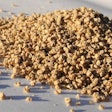Unprecedented rises in feed prices over the past year are now a matter of record. The cost of almost all feed ingredients, especially corn, soya bean meal phosphate, fat and even vitamins has increased far beyond what might have been expected.
Various factors lie behind these increases and their respective impacts have been widely debated. What is certain, however, is that the massive diversion of feed ingredients to biofuels, lower crop yields, and growing demand for animal proteins from developing countries have all contributed to push prices higher.
Whenever feed costs cycle upwards, interest increases in the feasibility of using alternative ingredients. Understandably, interest in alternatives is currently strong.
What exactly constitutes an alternative ingredient is also an open question. To some in the feed industry, any energy or protein source other than corn, soya bean meal and fat is taken to be alternative.
A better working definition of alternative ingredients would be those that:
New ingredients
There are very few materials of either plant or animal origin that have not been tried as feed ingredients.
This is not to say that new ingredients do not occasionally arise, although any such ingredients are usually only available in limited supplies and on a local basis. It is safe to assume that there are few, if any, industrial quantities of a previously unknown ingredient ready for immediate purchase.
Additionally, the abundance, and generally favourable pricing, of corn and soya bean meal have resulted in a situation where, despite extensive research, there has been little actual demand for alternative ingredients.
In the Southeastern USA, for example, cottonseed meal, peanut meal and local wheat all merit more consideration. Other alternative ingredients that may not have been fully considered in the past are the by-products of the biofuel industry, catfish meal and pearl millet.
Others, such as bakery meal and animal protein meal, are now so widely used that they can no longer truly be called alternative.
Nutrient content
The feed industry may be familiar with most alternative ingredients and their respective nutrient compositions have been established. However, there is a further complication when considering alternatives.
Alternatives tend to be produced in relatively small facilities with variations in manufacturing procedures. A common result is that the same ingredient may vary markedly in nutrient composition when procured from a variety of sources.
A prime example of this variation is dried distillers grains plus solubles (DDGS), which is currently produced at more than 120 locations worldwide. The protein content of meals from these plants varies from less than 26% to over 29%. If variations of this magnitude were to exist in soya bean meal, the high and low protein samples would not even be sold as the same ingredient.
While the nutrient composition of most alternatives is known, anyone considering their use should request samples from suppliers to properly evaluate an individual ingredient's nutrient profile.
Possible risks
Almost all ingredients have an "Achilles' heel," or an aspect of their composition that demands the nutritionist's attention prior to use. In the case of sorghum, this might be tannins, for feed fats oxidative stability, moisture, impurities and unsaponifiables, and possible residues, and for corn mycotoxin contamination.
The maximum level of inclusion of alternative ingredients is, to a large extent, based on such considerations, along with actual determined nutrient composition.
Cottonseed meal, for example, contains gossypol, which can discolour the interior of eggs. This precludes its use in laying hen feeds. Sources of cottonseed meal with low levels of gossypol can be successfully used in broiler diets and pullet feeds, but such inclusion is likely to be limited by the low content of both total and available lysine.
Peanut meal is also low in lysine, but additionally carries a risk of aflatoxin contamination. However, when purchased from a reputable supplier, peanut meal can be a valuable ingredient as it is high in energy, protein and the essential amino acid arginine.
It is questionable whether significant savings can be had by using alternative ingredients. Economically beneficial relationships can be developed with suppliers, but prices of ingredients with a similar nutrient content almost always rise and fall in tandem.
The unfortunate reality of alternative ingredients is simple: there are no cheap trainloads of a new grain in Manitoba, or an undiscovered oilseed in Mississippi.






